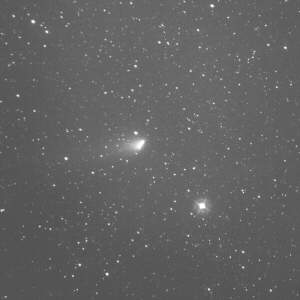Comet 21P/Giacobini-Zinner
This week's photo is a good example of how not to photograph a comet. However, being a holiday weekend and considering the fact that I will not solve the problem anytime soon, I am posting it anyway. On a positive note, it demonstrates a few facts of cosmic life that may not be obvious to the casual observer.

Comet Giacobini-Zinner
This photo makes the comet look more like a flying stick than what we think of as
a comet. However, you will note that the stars are points of light which indicates
that the telescope was doing what it is normally expected to do, viz., tracking the
stars with great precision. However, being much closer than the stars, comets
impart their own motion relative to the background stars which can not be
compensated for simply by moving the telescope as the world turns.
The result is that the comet nucleus is a streak whose length represents the distance it traveled during the 20 minutes the film was being exposed. This is most noticeable when comets near the sun as they move much faster than when far away. The proper way to take this photo would have been to have the telescope track the comet instead of a star. This would result in the stars being streaks but the object was to photograph the comet and this would have looked normal.
The reason I had to take it this way was because it was one of the compromises I had to make when switching from the 10" to the 16" telescope. The larger scope flexes too much with changing position to allow the use of a piggyback guide scope which could track the comet independantly of the stars.